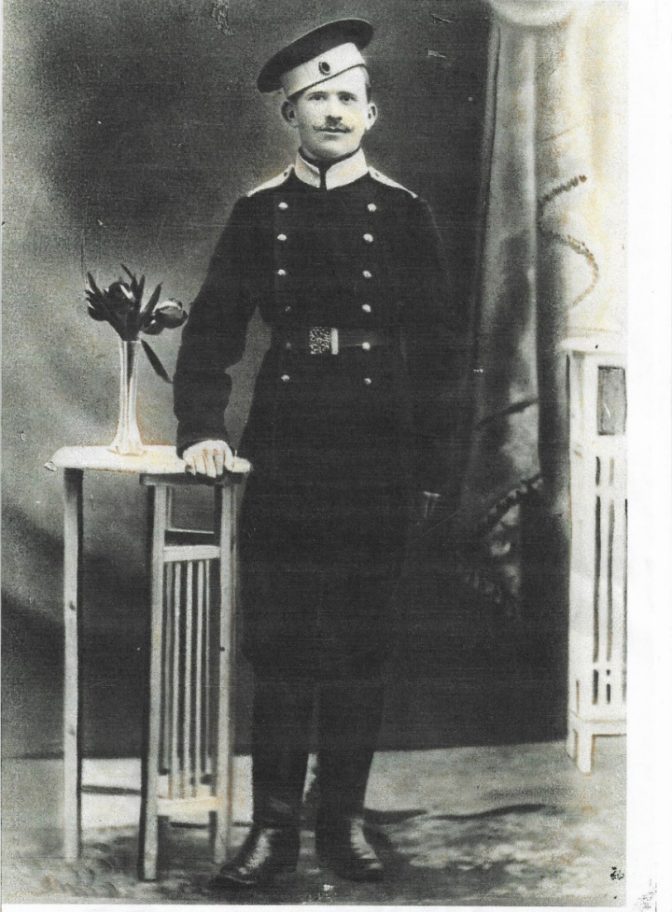Biography of Meyer Leib Gurschbarg, born in Bardichev, Russia, in 1888, died in 1944
This biography was written by two 11th grade classes (1°ES2 and 1°ES1) from the “Lycée Simone Veil de Boulogne” high school, supervised by Madame Le-Nuz, their Literature and History teacher, during the 2018-2019 school year.
Photograph of Meyer Leib Gurschbarg pictured in the Russian soldiers’ uniform
This biography, originally written from the point of view of Bruma, Meyer Leib’s wife, has been kept in the same format here.
“My name is Bruma; Bruma Gurschbarg. I was born on February 14, 1892 in Liachowici, Russia. I am the daughter of Rachel Koupermann and Zanvel Abramovitch and I married Meyer Gurschbarg, a cobbler, on July 16, 1918 at the town hall of the 11th district of Paris. Our parents lived in Russia but my mother was deceased. Meyer was a little older than me; he was born on December 23, 1888 in Barchditer, also in Russia. He was the son of Paltiel Gurschbarg and Sara Michelmann. I had four beautiful children with him!
We moved to Paris as immigrants and we lived in a quiet area of the 18th district, at 1 rue Fernand Labori. We lived there with Clara and Maurice, while Rebecca lived with her mother-in-law a short distance away. There was Paul too, but he never had a chance at life; he was stillborn and ascended to heaven a few years ago now. Our first daughter, Rebecca, was born on August 28, 1918, at the Rothschild Hospital, Rue Santerre in the 12th district. We were then living at 22 Passage Raguinot. She married a non-Jew on August 21, 1941. His name was Georges Siegel, born on May 23, 1914. Rebecca and Georges lived together at 15 rue du Simplon in the 18th district at Georges’ mother, Marie Bergeaud’s house. His father, Constant, was deceased. Rebecca and Georges gave us a sublime gift: the only grandchild I have ever known, Daniel, who was three years and nine months old. We were already living in rue Fernand Labori when our second daughter, Clara, was born on July 15, 1929 at 4, rue de Jessaint. She worked for a vanilla sugar company before we were arrested. It was she, shortly before her death in 2013, who told Daniel our story. Our third child Maurice, a boy, was born on November 9, 1931 at Lariboisière Hospital, rue Ambroise Paré, in the 10th district of Paris. He went to school on rue Gustave Rouanet, not far from home. I had two more children who died of illnesses as adults, so six children in all. Despite the pain of the loss of three of them, we managed to build a truly beautiful, united family that filled Meyer and I with joy.
This story begins on July 18, 1944. I got up early that morning to go shopping. I left my husband, Clara and Maurice at home. It was during this short absence that the police came knocking on the door asking for the family record book. They visited all the apartments in the building, Meyer told me when I came home. The officers then asked us and the Hoffmans, another Jewish family in the building, to get dressed and to go with them. We knew this family well because our little Daniel used to play with Nathan, their four-year-old son. It was then that our daughter Clara, in a fit of rage, unexpectedly grabbed the inspector by the coat and shouted, “What have we done to you?”. Faced with her insistence and desperation, the inspector asked us if there was anyone who could hide our two children in the building. My neighbor on the fifth floor agreed to hide them. I discreetly took Father Devaux’s address out of my bra and slipped it to Clara so that they could take refuge there.
The apartment was sealed up there and then. I stooped down one last time to kiss my children and told Clara to be sensible, to become a seamstress to get by in life and to be kind to her sister. We had to leave. We were leaving. I only had one souvenir from this life on me that day, a medallion with the portrait of our one and only grandson. Of course, I regretted not having taken the inspection of our papers a fortnight earlier more seriously, but we were told we had to leave! However, the inspector had also told us that our French naturalization would protect us and ensure our safety; and we took him at his word. We had both become French citizens by naturalization on August 24, 1925.
We left for the Drancy camp with the whole Hoffman family: Leon and his wife Rifka (born in 1888 and 1897), Sarah, who was 21 years old, Maurice,13, Juliette, 10 and Nathan, who was 4. We arrived there on July 20. My husband was given the number 25304 and I was given the next number, 25305. We stayed there for 10 days, and then on July 31 we were taken to the train station and boarded a convoy to Auschwitz in Poland, where my husband and I were murdered and burned to ashes upon arrival on August 5, 1944, solely because we were Jews”.
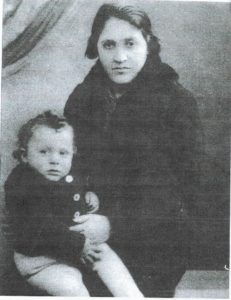
Rifka Hoffman and her son Nathan
Bruma and Meyer never knew, but Clara and Maurice were to live and escape deportation thanks to the address slipped to Clara. Rebecca, who didn’t wear the yellow star and hadn’t been registered as a Jew also survived, and it is the reckless Clara who explains how. Maurice and Clara hid in the apartment of the neighbor on the 5th floor, who took it upon herself to inform Rebecca of the arrest. Very soon after that, Rebecca’s husband Georges came to get them and take them to the apartment he occupied with his mother and wife, at 15, rue du Simplon in the 18th district. Clara and Maurice stayed there for six weeks, hiding on the ground floor during the day, and sleeping on the 5th floor, destroyed by bombing, during the night. Then Georges took Clara and Maurice to a church in Montparnasse where they were immediately given new names. They became Clara and Maurice Siegel, taking the surname of Rebecca’s husband. It was probably the Monastery of the Fathers of Notre-Dame-de-Sion, located at 68 rue Notre Dame des Champs in the 6th district, of which Father Devaux was the superior. This monastery had been founded by Jews who had converted to Catholicism. On the initiative of Father Devaux, the Fathers of Notre-Dame-de-Sion hid more than 400 children. Father Devaux has since been recognized as one of the Righteous of the Nations.
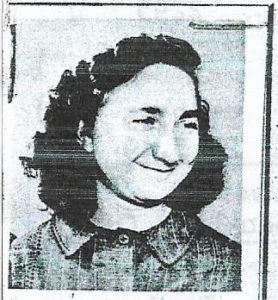
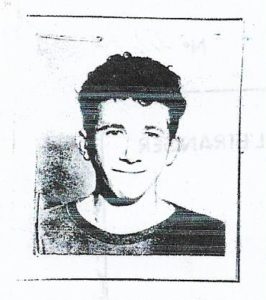
Clara and her brother Maurice Gurschbarg
Life continued for these two young destitute orphans, but it was not easy for them. They were first placed in a Catholic children’s center on rue d’Alesia in the 14th district of Paris, where they remained until the Liberation. After that, they went to a synagogue on rue de Montevideo in the 16yh district, where Clara stayed for two months, while Maurice went to a children’s home in the Château de Corbeville near Orsay (Seine) in November 1945. He then went to another, called “Champfleurs”, at 6, avenue de la République in Mesnil-le-Roi in November 1946, then to the children’s home in Champigny in October 1947 and then to the OSE house in Bellevue in September 1948. He finally went to a Catholic institution, at 28 avenue de Chevreuse in Clamart. In October 1947, he became an apprentice shoemaker and in October 1949 an apprentice diamond dealer. He now lives in Israel.
Clara was placed by Rebecca with one of her former patrons, Madame Berthot d’Aizenville, in the Seine et Oise department before being admitted to the girls’ home “le Masse Abri” in Saint Germain en Laye, also Seine et Oise, in November 1945 and then to another located at 4 rue Notre Dame des Victoires in the 2nd district of Paris.
On February 4, 1950, Rebecca obtained “disappearance certificates” as well as death certificates for her parents. It was not until March 1955 that political deportee cards were issued and thus they were officially acknowledged by the Department of Veterans and War Victims.
The arrest of Bruma and Meyer Gurschbarg, 1944
Mr Daniel Siegel’s account
My grandparents were arrested on July 18, 1944. A fortnight before that they had had their papers checked by a police inspector who had come to their home. Since they were naturalized French citizens, the inspector told them that they had nothing to fear. They therefore decided to stay at home although some of their neighbors told them that they should leave.
On the morning of July 19, my grandmother got up very early, around 6 a.m., to go shopping; in those days the grocery stores were already open at that hour.
My grandfather, along with Clara and Maurice, two of his children, remained at home.
Around 6:15 a.m. there were loud knocks on the door; “Police”. The officer asked to see the family record book.
The family records also mentioned the names of my mother, Rebecca, the elder sister of Clara and Maurice, and also that of a younger child, Paul, who died at birth. The officer asked where Rebecca was. My grandfather said they were angry with her, because she had married a goy (non-Jew), and therefore he did not did not know where she was. In fact, my grandparents liked my father very much and they weren’t really angry. My mother was staying with her stepmother at 15, rue du Simplon in the 18th district of Paris. She didn’t wear the yellow star and she hadn’t registered as a Jew.
In the building where my grandparents lived there was only one other Jewish family, the Hoffmans. The officers said to both families “Get dressed.” Juliette Hoffman, with her little brother Nathan in her arms, jumped out of the first floor window, but they were picked up by the officers who took the whole family, six people in all I believe, including Nathan, who was four years old and who, according to my aunt Clara, was my first playmate. I was only three years and nine months old at the time.
Juliette had had time to call my aunt, who had quickly sewed back on her yellow star. Clara then grabbed the inspector by his coat and shouted, “What have we done to you?”. At my Aunt Clara’s insistence, the inspector asked her if anyone in the building could hide her and her brother Maurice. My grandmother already had their suitcase ready. She took the address of Father Devaux out of her bra and gave it to Clara so she could take refuge there. The door of their apartment in the building at 1 rue Fernand Labori in the 18th district was then sealed.
My grandmother, before leaving with her husband, told Clara to be serious, to become a seamstress and to be nice to her sister (my mother Rebecca) and then she left with only a locket bearing a picture of me, Daniel, her only grandson, after a last hug with Clara and Maurice.
A neighbor on the 5th floor of the building looked after my uncle and aunt and she also notified my mother (my aunt could not remember the name of this neighbor when she told me the details of the arrest). My father hastily came to fetch them and took them to the apartment he shared with his own mother and his wife, my mother Rebecca.
Clara and Maurice stayed there for a few weeks. They stayed on the ground floor of the building during the day, and to sleep at night they went up to an apartment on the fifth floor of the building, which had been bombed.
Before their parents’ arrest, Clara worked in a vanilla sugar company on rue Vincent Compont and Maurice went to school on rue Gustave Rouanet.
My father went to see Father Devaux and then he took Maurice on the handlebars of his bicycle and Clara on the luggage rack at the back, along with a suitcase, to a church in Montparnasse. The priest immediately gave them new names: Clara and Maurice Siegel and forged food ration cards. Then they went to a Catholic center 7 rue Jacquier in the 14th district of Paris, where they stayed until the Liberation. After the Liberation they went to the synagogue in rue de Montevideo in the 16th district. Clara stayed there for two months and Maurice went to a Catholic institution.
My Aunt Clara told me of these events shortly before her death in 2013.
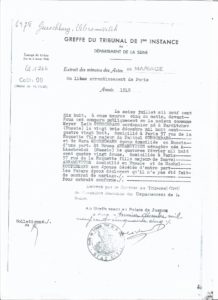
Marriage Certificate issued by the town hall of the 11th district of Paris, dated 16.07.1918

Nationality Certificate issued by the town hall of the 11th district of Paris, dated 16.07.1918
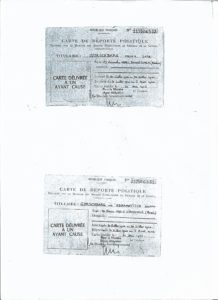
Political deportee cards for Bruma and Meyer Gurschbarg
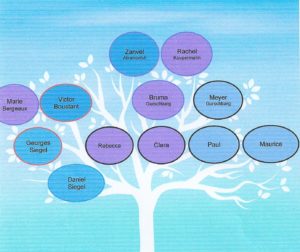
This family tree, drawn by the pupils, shows the ascendants at the top and descendants at the bottom. It enables the reader to identify all of the family members mentioned in the biography.
Contributor(s)
Two 11th grade classes, ES2 et ES1 at the “Nouveau lycée de Boulogne”, high school, supervised by Madame Le-Nuz, their Literature and History teacher, in the 2018-2019 school year, and Daniel Siegel, grandson of the Gurschbarg couple.


 Français
Français Polski
Polski